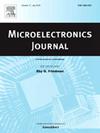氮化镓的热反射特性
IF 1.9
3区 工程技术
Q3 ENGINEERING, ELECTRICAL & ELECTRONIC
引用次数: 0
摘要
根据热反射(TR)原理和实验数据,我们测定了氮化镓在可见光和近紫外光谱范围内的 TR 系数。结果表明,当照明波长在近紫外范围内时,氮化镓的 TR 系数较大,约为 10-3K-1。然而,在可见光谱范围内,TR 系数较低,在 10-5K-1 到 10-6K-1 之间。这表明,在近紫外光谱范围内,氮化镓对温度变化的反应更为灵敏。本文为这一现象提供了基于物理机制的解释。这些结果对基于氮化镓的微电子器件的热设计和分析具有重要意义。本文章由计算机程序翻译,如有差异,请以英文原文为准。
Thermoreflectance property of gallium nitride
Based on the principle of thermoreflectance (TR) and experimental data, we have determined the TR coefficients of GaN in the visible and near-ultraviolet spectrum range. The results indicate that the TR coefficient of GaN is larger, approximately when the illumination wavelength falls within the near-ultraviolet range. However, within the visible spectrum, the TR coefficient is low, ranging between to . This suggests that GaN is more responsive to temperature changes within the near-ultraviolet spectrum. The paper provides a physics-mechanism-based explanation for this phenomenon. These results have implications for the thermal design and analysis of GaN-based microelectronic devices.
求助全文
通过发布文献求助,成功后即可免费获取论文全文。
去求助
来源期刊

Microelectronics Journal
工程技术-工程:电子与电气
CiteScore
4.00
自引率
27.30%
发文量
222
审稿时长
43 days
期刊介绍:
Published since 1969, the Microelectronics Journal is an international forum for the dissemination of research and applications of microelectronic systems, circuits, and emerging technologies. Papers published in the Microelectronics Journal have undergone peer review to ensure originality, relevance, and timeliness. The journal thus provides a worldwide, regular, and comprehensive update on microelectronic circuits and systems.
The Microelectronics Journal invites papers describing significant research and applications in all of the areas listed below. Comprehensive review/survey papers covering recent developments will also be considered. The Microelectronics Journal covers circuits and systems. This topic includes but is not limited to: Analog, digital, mixed, and RF circuits and related design methodologies; Logic, architectural, and system level synthesis; Testing, design for testability, built-in self-test; Area, power, and thermal analysis and design; Mixed-domain simulation and design; Embedded systems; Non-von Neumann computing and related technologies and circuits; Design and test of high complexity systems integration; SoC, NoC, SIP, and NIP design and test; 3-D integration design and analysis; Emerging device technologies and circuits, such as FinFETs, SETs, spintronics, SFQ, MTJ, etc.
Application aspects such as signal and image processing including circuits for cryptography, sensors, and actuators including sensor networks, reliability and quality issues, and economic models are also welcome.
 求助内容:
求助内容: 应助结果提醒方式:
应助结果提醒方式:


